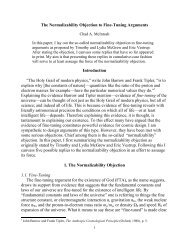Theism and Explanation - Appeared-to-Blogly
Theism and Explanation - Appeared-to-Blogly
Theism and Explanation - Appeared-to-Blogly
You also want an ePaper? Increase the reach of your titles
YUMPU automatically turns print PDFs into web optimized ePapers that Google loves.
164 Appendix<br />
If this line of criticism is correct, then the distinction both Davidson <strong>and</strong> I<br />
favour can, in fact, be maintained.<br />
A.3.3.2 The Prediction of Behaviour<br />
In any case, let me come back <strong>to</strong> my initial question. Does the lawlessness<br />
of intentional explanations mean that such explanations are not independently<br />
testable? No, it does not. If I have certain beliefs <strong>and</strong> desires, then—<br />
assuming I am a rational agent—this will have predictable consequences.<br />
Since those consequences extend beyond the fact <strong>to</strong> be explained, an intentional<br />
explanation will be independently testable. If you see me walking<br />
in<strong>to</strong> the bank <strong>and</strong> posit that I intend <strong>to</strong> rob it, then you can form a pretty<br />
accurate idea of how I would act, on the assumption that this is true. You<br />
may predict, for instance, that I will make some effort <strong>to</strong> hide my identity,<br />
or that I will approach a teller <strong>and</strong> issue some kind of threat. And there are<br />
things you would not predict, whose occurrence would fail <strong>to</strong> corroborate<br />
the hypothesis. If I intend <strong>to</strong> rob the bank, you would not expect me <strong>to</strong> fi ll<br />
in a deposit form or <strong>to</strong> approach the teller <strong>and</strong> discuss the weather. The<br />
more successful predictions you make, the more we have the consilience of<br />
confi rmed deductions that will corroborate your explanation. Such predictions<br />
do not depend on laws, but they are nonetheless predictions, which<br />
can be tested.<br />
It is true that we can attribute extra beliefs <strong>and</strong> desires <strong>to</strong> our agent in<br />
order <strong>to</strong> explain why she did not act as we might expect. (This seems <strong>to</strong> be<br />
Davidson’s point about the “holism of the mental.” 69 ) But the parallel here<br />
with the sciences is quite precise. It is always possible <strong>to</strong> amend a scientifi c<br />
theory by way of auxiliary hypothesis so as <strong>to</strong> prevent its falsifi cation. This<br />
is a corollary of the Duhem-Quine thesis, which points out that hypotheses<br />
are not tested one-by-one, but in bundles (as it were). But this does not<br />
prevent scientifi c theories from being independently testable. On the one<br />
h<strong>and</strong>, we can often test the auxiliary assumptions independently. 70 On the<br />
other h<strong>and</strong>, the reformulated theory (that is <strong>to</strong> say, with the new auxiliary<br />
assumptions) can be used <strong>to</strong> make new predictions. At the end of the day,<br />
we may have <strong>to</strong> recognise that the theory in question represents a “degenerating<br />
research programme” <strong>and</strong> that the most rational thing (particularly if<br />
a better explanation is on offer) would be <strong>to</strong> ab<strong>and</strong>on it. 71<br />
A.3.4 An Illustration<br />
Let me illustrate the points I have been making by borrowing <strong>and</strong> adapting<br />
one of Jaegwon Kim’s examples. 72 Let’s say you are in a meeting with your<br />
colleague Sally. You see her st<strong>and</strong> up <strong>and</strong> move around the room. Since you<br />
already know that the room is stuffy, you conjecture that Sally intends <strong>to</strong><br />
get some fresh air. If this were true, it would explain her behaviour. So it<br />
is a potential explanation. But is it the actual one? After all, many other<br />
intentions might explain her moving around the room. To conclude that



